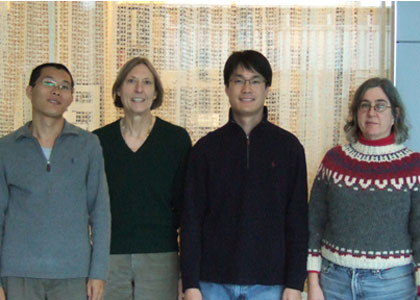Meiosis is a modified cellular program by which a single diploid cell gives rise to haploid gametes (e.g. sperm and egg). To this end, DNA replication is followed by a complex program of interactions between the corresponding maternal and paternal versions of each chromosome (homologs). A central component of these interactions is recombination at the DNA level which, universally, is initiated by programmed double-strand breaks (DSBs).
The final outcome of the meiotic interhomolog interaction program is a configuration in which, after further chromosome compaction, each pair of replicated homologs is connected at one or a few specific points via cytologically-visible features known as “chiasmata” (A). Within this configuration, homologs are connected by the combined effects of DNA crossovers, involving exchange of chromosome arms between one sister of each homolog, and linkages between sister chromosomes along their lengths (B). This situation creates a paradox. On the one hand, globally, sister connections are essential. On the other hand, locally at sites of recombination, which must occur specifically between homologs and not between sisters, sister chromosomes must be differentiated and separated from one another. An additional challenge to achieving this configuration is the fact that recombination must occur specifically between non-sister chromatids of homologs, which are initially located far away in space, rather than between sister chromosomes, which are being held in close proximity to one another. A recent paper from our laboratory (Kim et al, Cell Dec. 10, 2010) provides insight into how meiotic chromosomes solve this latter challenge.
Using budding yeast strains undergoing normal or mutant meiosis, we analyzed meiotic recombination at the DNA level, at a particular “hot spot”. One- and two-dimensional gels were used to identify, and discriminate among, relevant DNA species, with special attention to the relative probabilities that key intermediates formed between non-sister (homolog) chromosomes versus between sisters (C). Mutant phenotypes reveal that one particular set of meiosis-specific structural components (Red1/Hop1 and the associated kinase Mek1) acts locally at sites of recombination to counteract the effects of a sister chromatid linking molecule (Rec8 cohesin). Thus: if sister links are absent, Red1/Hop1/Mek1 is no longer necessary and homolog bias is efficiently established; and if sister links are then restored via a suppression mechanism, the requirement for Red1/Hop1/Mek1 is also restored. These effects reveal that, while the action of Red1/Hop1/Mek1 to eliminate sister links is essential for recombination to occur between homologs, it is not the fundamental basis for this bias, which remains to be elucidated. Additional findings reveal that, even if homolog bias is properly established, it can then be lost later in the recombination process and that, paradoxically, for this maintenance of bias, Rec8 cohesin plays a positive role, rather than the inhibitory role exerted for establishment of bias (above). Establishment of recombinational partner choice requires that a DSB search the entire genome for the homologous sequence on the homolog, which is located elsewhere in the nucleus. Additional presented results support a model in which only one of the two ends of DSB is engaged in searching. This first end is specifically released from the initiating complex on the donor chromosome while the second end remains behind (D). Further, release of this first end is predicted to create a nucleus-scaled homology-searching tentacle thus permitting homology scanning and detection without the need for dramatic stirring forces to bring donor and target regions into spatial contact. Our laboratory has proposed previously that evolution of the complete meiotic program requires the integration of general cellular double-strand break repair mechanisms and late-stage mitotic chromosome morphogenesis. The results presented in Kim et al. (2010) suggest that Red1/Hop1/Mek1 and Rec8 cohesin represent these two types of inputs and that they mediate their coordinate effects via differential localization to spatially distinct domains along the chromosomes.


